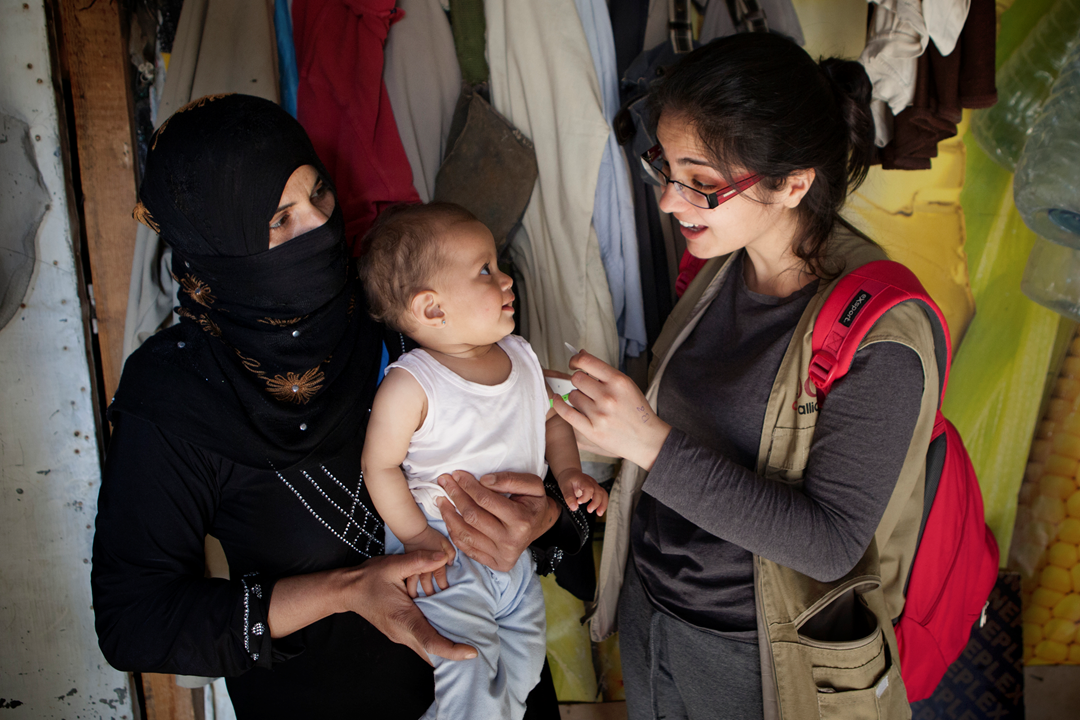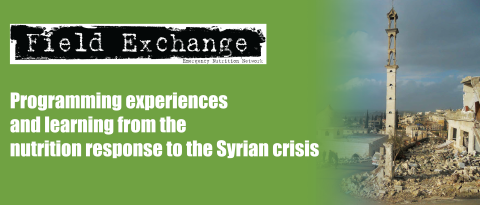Institutionalising acute malnutrition treatment in Lebanon
 By Linda Shaker Berbari, Dima Ousta and Farah Asfahani
By Linda Shaker Berbari, Dima Ousta and Farah Asfahani
Linda Shaker Berbari is Country Representative at International Orthodox Christian Charities (IOCC) Lebanon and nutrition focal point for IOCC. She holds a Masters in Nutrition and is pursuing a PhD on infant and young child feeding in emergencies. Linda has more than ten years’ experience in community nutrition and development work.
Dima Ousta is the Health and Nutrition Coordinator at IOCC. She has an M.Sc in Human Nutrition and Diploma in RD. Credentialing and has participated at the NIE-Regional Training in 2012 in Lebanon. She joined IOCC in September 2013.
Farah Asfahani is the Health and Nutrition Area Coordinator for Beirut/Mount Lebanon region for the acute malnutrition treatment programme at IOCC. She has a B.Sc. in Nutrition and Dietetics and has participated in the Nutrition in Emergencies (NIE)-Regional Training in 2012 in Lebanon. She joined IOCC in July 2013.
The authors extend thanks to UNICEF and UNHCR for funding the trainings and staff and for supporting the treatment of children with acute malnutrition. Thanks also to the MoPH for supporting and facilitating the establishment of the programme through its established network of primary and secondary health centres. Finally, the authors gratefully acknowledge the support of the American University of Beirut, particularly Dr. Hala Ghattas and Dr. Omar Obeid, and of Caroline Abla at International Medical Corps, for providing technical input and guidance on the development of the programme and training material.
Lebanon is a middle income country that has had to endure a number of wars and emergencies since 1975. Throughout those different emergencies, Lebanon has never had a nutrition crisis, even during previous periods of civil war. Today, with more than 1 million Syrian refugees hosted in the country, there is fear that due to the underlying causes of malnutrition, acute malnutrition may be a problem that the Lebanese health system may have to deal with. The Lebanese heath system is considered one of the strong services in the country, especially within the private sector. However, most nutrition and health problems that the system is equipped to face include problems that are related to overnutrition rather than undernutrition. At the outset of this crisis, Lebanon did not have any protocols for treatment of acute malnutrition, health care providers were not familiar with the different forms of malnutrition that may arise during emergencies, and health services were not equipped to respond to such crises.
 Nutrition programme
Nutrition programme
International Orthodox Christian Charities (IOCC) started its nutrition programme in 2012, focusing on emergency preparedness that mainly involved capacity building activities for health care providers. From 2011 to 2013, as the number of refugees increased and cases of acute malnutrition started to appear, there was a need to provide case management. The ensuing acute malnutrition treatment programme is implemented by IOCC with support from UNICEF and UNHCR and in partnership with the Ministry of Public Health (MoPH) in vulnerable localities1 in all six of Lebanon’s governorates. Lebanon’s six governorates are made of 26 cadasters; IOCC works in more than 15 cadasters to support the nutrition programme. The IOCC programme aims to institutionalise acute malnutrition treatment to ensure primary health centres (PHCs) have or will have the capacity to treat acute malnutrition; it is both a preparedness activity and an intervention. Key activities are as follows:
 Activation of PHCs for the screening and management of acute malnutrition through capacity building and provision of on-the-job support
Activation of PHCs for the screening and management of acute malnutrition through capacity building and provision of on-the-job support
As Lebanon already has an established network of PHCs providing health services to both the Lebanese and the Syrian refugee community, the acute malnutrition treatment programme relies on this existing structure. There are more than 800 centres in Lebanon that provide health services that are registered with the MoPH. However, only around 180 are part of the Network of PHCs; these are PHCs accredited by the MoPH that provide a comprehensive list of services. Many of these centres are privately owned or supported by local organisations. Whether part of the Network of PHCs or not, at the outset of this crisis, none of the centres was equipped to, or even knew about, how to screen and manage acute malnutrition. Therefore, IOCC’s programme targeted 50 PHCs across the country with facility-based trainings.
.jpg?w=225) Since May 2012, this training of health care staff (doctors, nurses, social workers) has been implemented by IOCC with technical assistance from the American University of Beirut (AUB) and International Medical Corps (IMC). The training material is a translated adaptation of the harmonised training package (HTP)2. As the training progressed, IOCC began to conduct its own trainings using IOCC staff who have been trained through either the Nutrition in Emergencies Regional Training Initiative (NIERT)3 or other nutrition in emergency trainings. To date (July 2014), the team has trained more than 250 health care staff across the country.
Since May 2012, this training of health care staff (doctors, nurses, social workers) has been implemented by IOCC with technical assistance from the American University of Beirut (AUB) and International Medical Corps (IMC). The training material is a translated adaptation of the harmonised training package (HTP)2. As the training progressed, IOCC began to conduct its own trainings using IOCC staff who have been trained through either the Nutrition in Emergencies Regional Training Initiative (NIERT)3 or other nutrition in emergency trainings. To date (July 2014), the team has trained more than 250 health care staff across the country.
Capacity is also built through provision of on-the-job support to selected PHCs whose staff have received the facility based training outlined above. These ‘activated’ centres, are selected for on-the-job support based on a number of criteria:
- They are located in the most vulnerable areas based on UNICEF’s priority list.
- The centre is contracted4 by UNHCR/ non-governmental organisation (NGO)/ to cover the cost of treatment.
- The centre has a paediatrician who is willing to be trained.
- The centre is willing to participate in the programme.
Activated PHCs provide a variety of services including screening for malnutrition amongst children under 5 years5, acute malnutrition treatment, education on nutrition and infant and young child feeding (IYCF), and provision of micronutrients for children under five years. Other population groups are only assessed or referred where acute malnutrition is suspected. IOCC provides on-the-job support by supplying IOCC staff who assist in screening for malnutrition amongst children under five years. IOCC staff also assist in case management and follow up on case treatment.
So far, IOCC has activated 30 centres across the country. Within the Syria response, there are around 97 centres that are contracted by UNHCR or international NGOs. Within those centres, only those activated by IOCC provide the acute malnutrition treatment services. Even where a centre is contracted by another INGO that subsidises the acute malnutrition treatment service, the training and follow up is all implemented by IOCC6.
Programme materials and supplies, including lipid-based Ready to Use Therapeutic Food (RUTF), Ready to Use Supplementary Food (RUSF)7 and equipment (e.g. height boards, scales, and MUAC tapes), are provided by UNICEF. With funding from UNICEF, IOCC has devised forms in Arabic to use at the PHCs for follow up on malnutrition cases.
Within each activated PHC, children under 5 years are assessed using mid-upper arm circumference (MUAC) and weight for height (WFH) measurements and for oedema. Children are admitted to the supplementary feeding or therapeutic feeding programme depending on the diagnosis. Children are provided with treatment at the PHC level through weekly or bi-weekly visits and are followed by trained staff at the community level as needed. Children with complicated severe acute malnutrition (SAM) are referred to secondary care for in-patient therapeutic treatment. On average, the IOCC-supported PHCs assess a total of around 125 children under 5 years per month, out of which around six children are admitted for acute malnutrition. It is important to note that the programme is still in development.
IOCC has also trained eight hospitals across the country on in-patient treatment of malnutrition8 using the WHO revised protocol for the treatment of malnutrition. All of these hospitals are contracted by UNHCR to provide services for Syrian refugees and cover the cost of treatment of malnutrition. Within each hospital, paediatricians and nurses on paediatric wards are trained in a one-day training. A dietician and paediatrician from IOCC then follow up with the staff on each case upon admission. An understanding was reached with each of the hospitals in terms of the roles and responsibilities of each party with regards to the treatment and follow up of admitted cases, as well as on the use of materials and supplies. Again, supplies such as F75, F100 and RUTF are provided by UNICEF.
An important step remains to integrate the management protocol within existing national and hospital protocols. To-date, IOCC has to rely on close follow up with hospital staff in order to make sure treatment protocols are followed.
Community screening for malnutrition
A major component of the IOCC programme involves screening for malnutrition within the community. IOCC deploys a group of trained screeners to different areas within Lebanon on a rotational basis to conduct community screening for acute malnutrition amongst children under 5 years using MUAC and oedema. This helps in early identification of cases who are then referred to activated PHCs for confirmation of diagnosis and treatment. Screeners have also been deployed to UNHCR registration and vaccination centres. Screening teams have mainly targeted informal tented settlements (ITSs) and collective shelters all over Lebanon and have conducted house to house screening in particular situations (e.g. in the village of Aarsal, at the time when a high influx of refugees fled from Syria in November 2013; a large number of refugees have been hosted by Aarsalis and have settled in unfinished houses since the beginning of the crisis in 2011). To-date, over 27,000 children have been screened (in the community and at registration centres) of which 450 were identified as malnourished and referred for treatment to the activated PHCs.
Education and awareness
In addition to screening and treatment, PHC staff provide education and raise awareness on nutrition for children, pregnant women and lactating women. Education topics include nutrition, IYCF, and hygiene. Resource material has been developed with UNICEF, UNHCR and the MoPH focusing on both acute malnutrition and IYCF.
.jpg?w=225) Integration of anthropometric indicators within existing health information system (surveillance)
Integration of anthropometric indicators within existing health information system (surveillance)
An integral and very crucial part of the nutrition programme involves establishing a pilot surveillance system within the MoPH. With the help of the primary health department at the MoPH, anthropometric measures (weight, height and MUAC) in addition to bilateral oedema were incorporated into the existing health surveillance system. Indicators include weight for height and height for age and an IYCF indicator (exclusive breastfeeding). The system is to be piloted and launched at the activated primary healthcare centres around October 2014.
Resource development
An important output of the project has been the development of resource material for screening and management of malnutrition. Referral sheets and treatment sheets for severe and moderate acute malnutrition were devised in Arabic and provided to activated PHCs. Staff were trained on the use of these forms. Another significant component of the programme included the development of training material in Arabic based on the HTP.
As Lebanon does not have a national protocol for the treatment of malnutrition, the team had to draw on protocols from other similar countries, such as the Yemen. These were adapted given the unique nature of, and accumulated experiences from, the Lebanon context. For example, the use of Amoxicillin in Lebanon has been debated by paediatricians due to high resistance to the antibiotic; thus, paediatricians were advised to replace with an alternative antibiotic. IOCC is working with the MoPH to formalise a national protocol for treatment that will be adopted by paediatricians.
Issues, challenges and lessons learned
There have been a number of challenges implementing acute malnutrition treatment in Lebanon. A primary challenge has been implementation in an urban context through existing health services in a country that has never had to provide these services before and with a view to long term sustainability.
A limiting factor has been the ability of PHC staff to accommodate additional services for patients visiting the PHCs. Multiple training at each centre was necessary to ensure appropriate capacity. It was essential to provide on-the-job support through additional staff, especially for regular growth monitoring (weight and height measurements). Finding physical space for the additional services was also a challenge.
There have been difficulties gaining understanding and uptake of treatment protocols amongst health care providers, notably paediatricians, who are not familiar with acute malnutrition. IOCC staff sometimes faced resistance from health care providers to implementing supplementary feeding or therapeutic feeding programmes. Paediatricians sometimes did not recognise and diagnose acute malnutrition as a condition.
The urban setting has rendered the follow up of cases more difficult. Given the movement of families within different areas and the reluctance of some families to address the issue of malnutrition, IOCC had to deploy health and nutrition educators to follow up cases at the community level in order to ensure regular attendance at centres. It was difficult to convince some families about the importance of seeking and finishing the treatment. For some, there was a perception that treatment for acute malnutrition was not a lifesaving intervention. Due to the distances between refugee residences and the activated centres, families often did not attend due to lack of transport. IOCC therefore had to fund transport costs for some cases.
A common challenge in the programme relates to the acceptability of RUTF and RUSF. Families and children are not used to receiving food/medicine in the form of a paste. In many cases, children do not accept the taste of RUTF and staff have to resort to alternatives such as mixing other nutrient dense products (e.g. NRG-5) with milk and juices, or adding RUTF to the child’s favourite foods (topping on bananas or biscuits).
The cost of attending PHCs can be prohibitive for some families, even though a number of PHCs are subsidised by UNHCR/NGOs, since families are required to cover 25% of the cost of consultation. IOCC has worked only with PHCs that are subsidised by other NGOs who have been covering 100% of the cost of acute malnutrition consultations. However, recent cuts in health care funding for the Syria crisis means that refugees are having to pay for some of the cost of treatment of malnutrition. This is hindering the success of care. In addition, often the medical treatment requires further testing for underlying causes of malnutrition (e.g. laboratory tests for anaemia, immunoglobulins, intolerances, CT-scans, endoscopies etc.) all of which are only subsidised at 85%9.
In many cases, children with acute malnutrition are also diagnosed with congenital or other associated diseases such as neurological disorders (e.g. cerebral palsy), cystic fibrosis, congenital heart disease, cow’s milk allergy, celiac disease, galactosemia, which often are the underlying cause of the acute malnutrition. In such cases, treatment of malnutrition has to be adapted to the case and condition.
Conclusions
The most important investment lies in institutionalising nutrition services within primary health, including those targeting both acute and chronic nutrition related diseases. Lebanon provides a unique context for implementation of an acute malnutrition treatment programme but building such capacity takes time. Other nutrition related problems need to be addressed as well, such as stunting, micronutrient deficiencies and other chronic nutrition related diseases that are endemic to the area. The establishment of a clinic-based surveillance system through the MoPH is expected to act as an essential step towards the strengthening of the primary healthcare structure in collecting growth monitoring data. This will act as a platform for capacity building to deal with acute and chronic nutrition-related conditions at the primary healthcare level.
For more information, contact: Linda Shaker Berbari, email: LBerbari@iocc.org
1 Map from UN Children’s Funds (2013). Equity in Humanitarian Action: Reaching the most vulnerable localities in Lebanon, October 2013, [online], Available through: www.data.unhcr.org?
2 Harmonised Training Package: http://www.unicef.org/nutritioncluster/index_67812.html
3 See article by AUB regarding the training initiative. http://www.nietraining.net/?
4 A ‘contracted’ centre is where UNHCR or an NGO subsidises the cost of treatment for medical consultations for Syrian refugees. Instead of paying the full fee for a medical consultation, the refugee pays a minimal fee. IOCC has prioritised contracted PHCs so as to make sure that the cost of acute malnutrition treatment is covered by UNHCR (in most cases) or an NGO.
5 Weight and height are measured but weight for height only is calculated.
6 Relief International provides treatment of malnutrition in mobile units and in specific areas of Lebanon but not in PHCs. See article in this issue of Field Exchange.
7 Products are Plumpy’nut, Plumpy’sup and NRG5.
8 Ashworth, A, Khanum, S, Jackson, A, and Schofield, C. (2013). Guidelines for the inpatient treatment of severely malnourished children. World Health Organisation.Available at: http://whqlibdoc.who.int/publications/2003/9241546093.pdf?ua=1

